System Analysis: NewAccess Project, Cloud Approach and SDLC Choice
VerifiedAdded on 2023/03/23
|10
|2102
|94
Report
AI Summary
This report provides a comprehensive system analysis of the NewAccess project, an electronic health record system proposed by Headspace. It identifies key non-functional requirements based on the FURPS+ model, including functionality, usability, reliability, performance, and security, emphasizing the importance of data confidentiality and system reliability. The report evaluates different cloud approaches—public, private, and hybrid—and recommends a hybrid cloud solution to balance cost-effectiveness with stringent security needs and controlled data accessibility. Furthermore, it advocates for an adaptive Software Development Life Cycle (SDLC) methodology to allow for flexibility and incorporation of client feedback during the project's execution. Ultimately, the analysis aims to ensure the successful implementation of the NewAccess project, meeting its objectives of secure and efficient storage of patient health information.
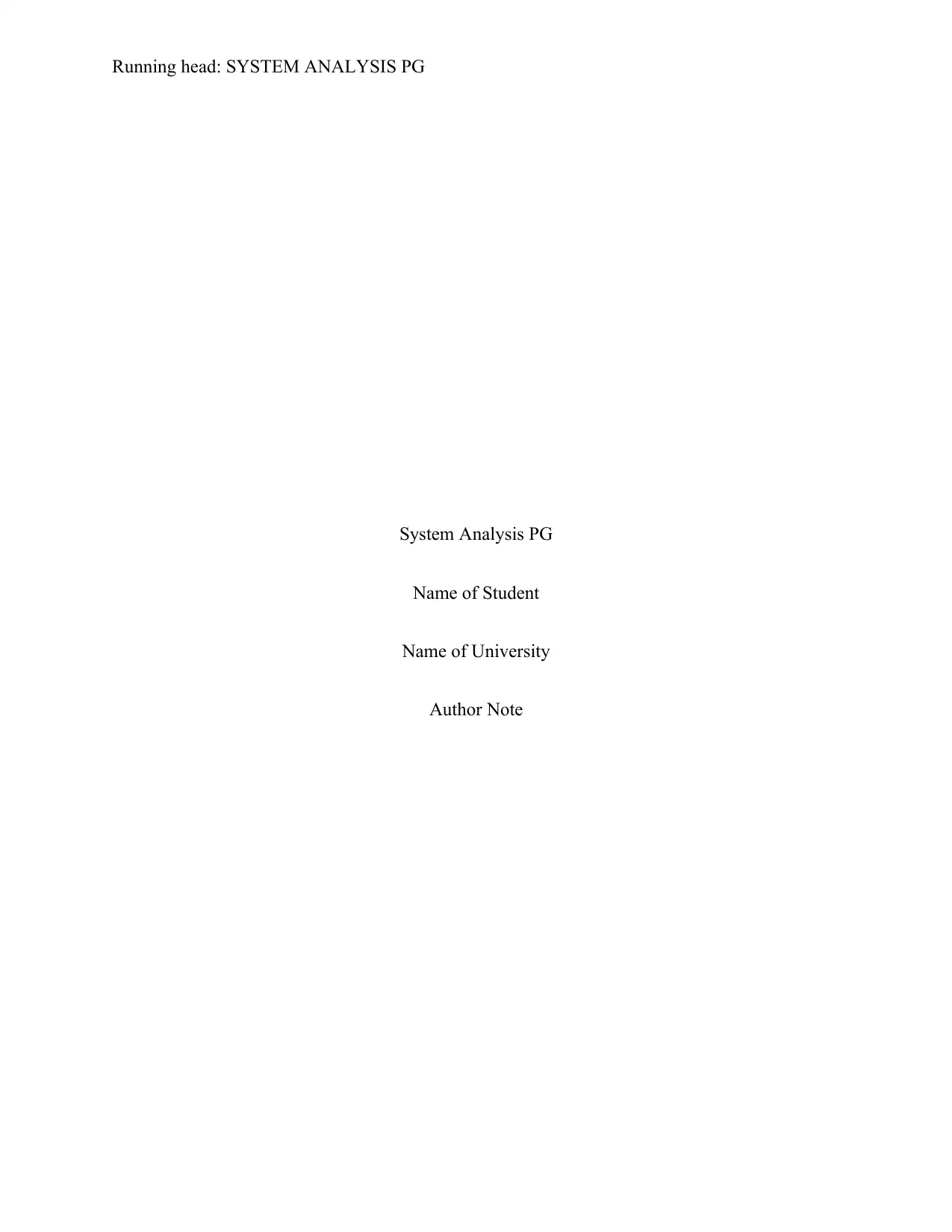
Running head: SYSTEM ANALYSIS PG
System Analysis PG
Name of Student
Name of University
Author Note
System Analysis PG
Name of Student
Name of University
Author Note
Paraphrase This Document
Need a fresh take? Get an instant paraphrase of this document with our AI Paraphraser
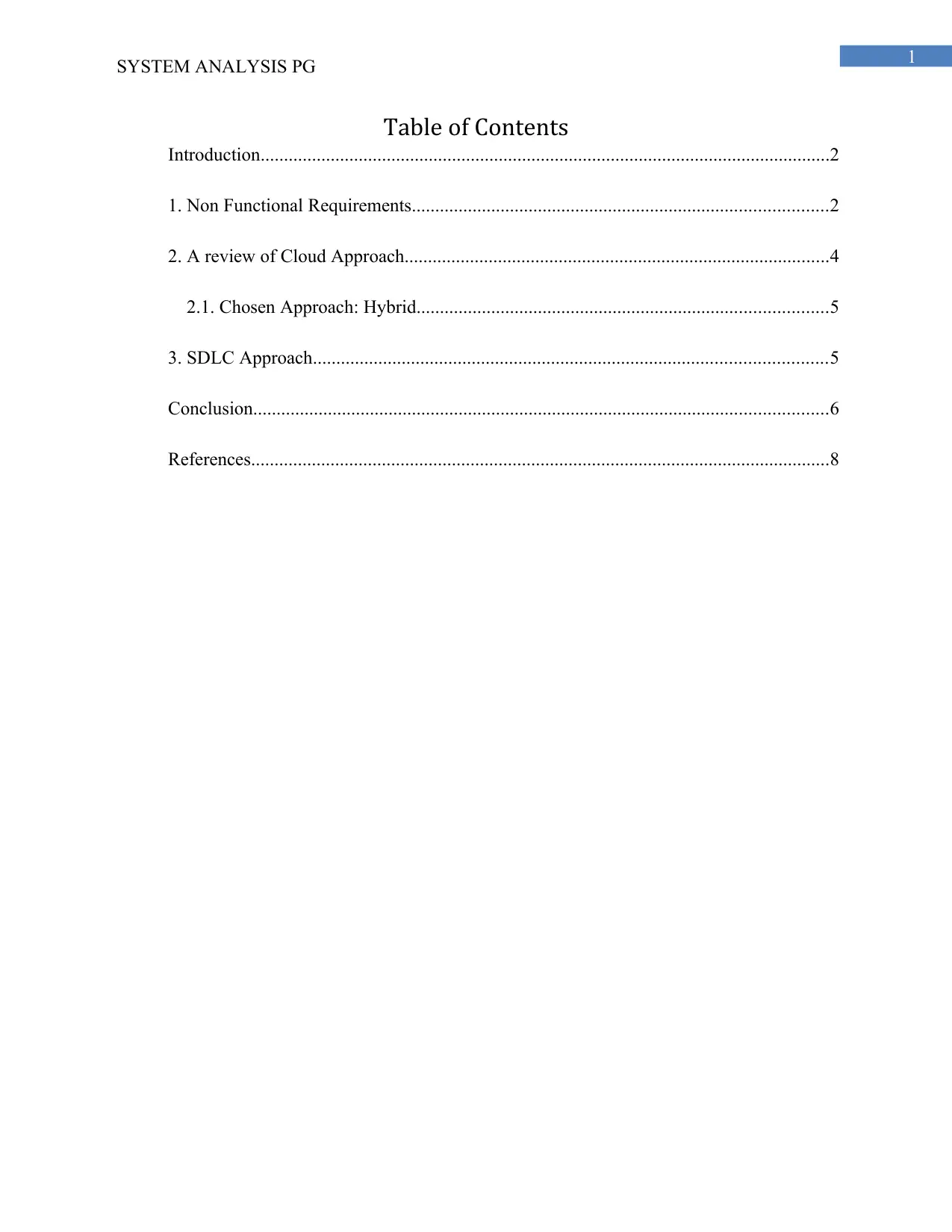
1
SYSTEM ANALYSIS PG
Table of Contents
Introduction..........................................................................................................................2
1. Non Functional Requirements.........................................................................................2
2. A review of Cloud Approach...........................................................................................4
2.1. Chosen Approach: Hybrid........................................................................................5
3. SDLC Approach..............................................................................................................5
Conclusion...........................................................................................................................6
References............................................................................................................................8
SYSTEM ANALYSIS PG
Table of Contents
Introduction..........................................................................................................................2
1. Non Functional Requirements.........................................................................................2
2. A review of Cloud Approach...........................................................................................4
2.1. Chosen Approach: Hybrid........................................................................................5
3. SDLC Approach..............................................................................................................5
Conclusion...........................................................................................................................6
References............................................................................................................................8
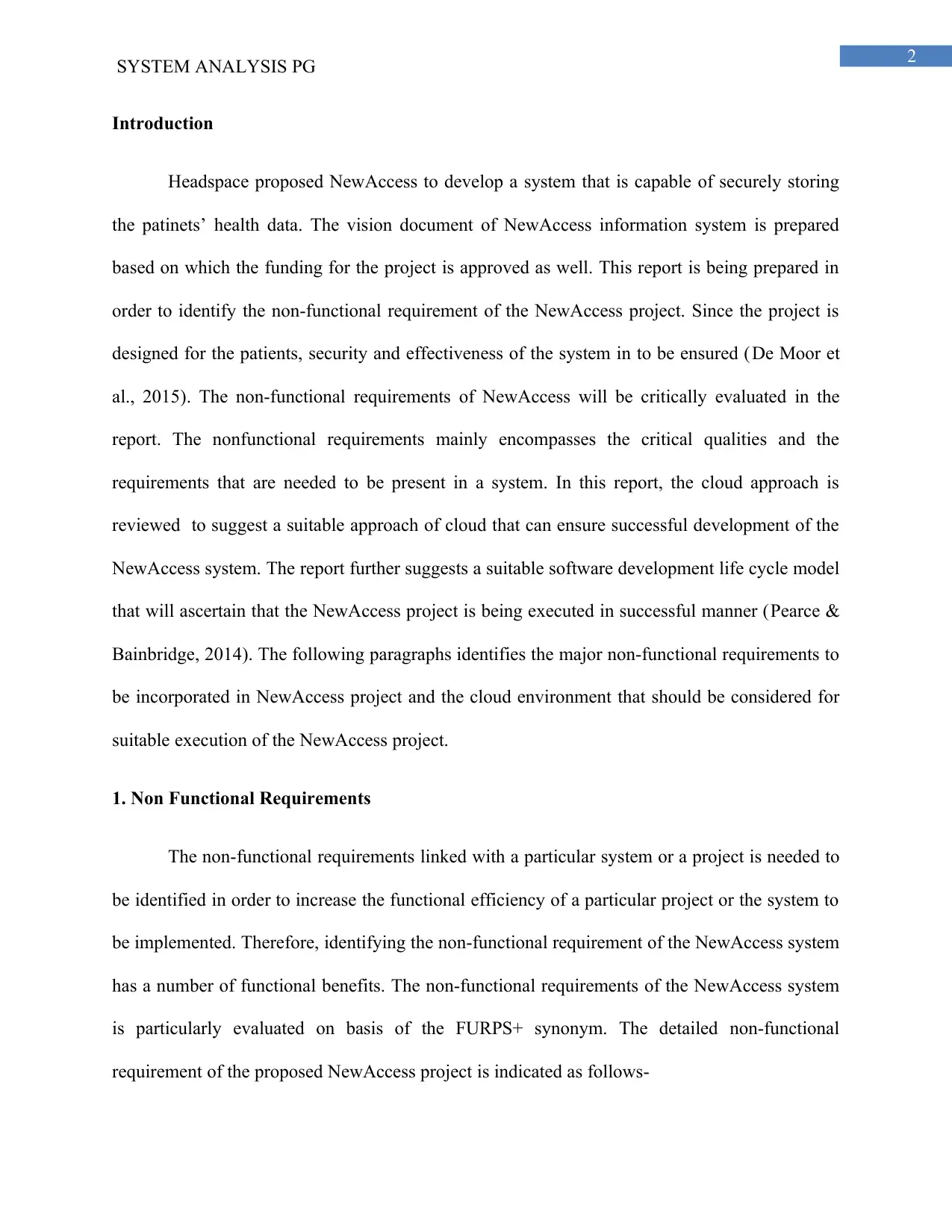
2
SYSTEM ANALYSIS PG
Introduction
Headspace proposed NewAccess to develop a system that is capable of securely storing
the patinets’ health data. The vision document of NewAccess information system is prepared
based on which the funding for the project is approved as well. This report is being prepared in
order to identify the non-functional requirement of the NewAccess project. Since the project is
designed for the patients, security and effectiveness of the system in to be ensured (De Moor et
al., 2015). The non-functional requirements of NewAccess will be critically evaluated in the
report. The nonfunctional requirements mainly encompasses the critical qualities and the
requirements that are needed to be present in a system. In this report, the cloud approach is
reviewed to suggest a suitable approach of cloud that can ensure successful development of the
NewAccess system. The report further suggests a suitable software development life cycle model
that will ascertain that the NewAccess project is being executed in successful manner (Pearce &
Bainbridge, 2014). The following paragraphs identifies the major non-functional requirements to
be incorporated in NewAccess project and the cloud environment that should be considered for
suitable execution of the NewAccess project.
1. Non Functional Requirements
The non-functional requirements linked with a particular system or a project is needed to
be identified in order to increase the functional efficiency of a particular project or the system to
be implemented. Therefore, identifying the non-functional requirement of the NewAccess system
has a number of functional benefits. The non-functional requirements of the NewAccess system
is particularly evaluated on basis of the FURPS+ synonym. The detailed non-functional
requirement of the proposed NewAccess project is indicated as follows-
SYSTEM ANALYSIS PG
Introduction
Headspace proposed NewAccess to develop a system that is capable of securely storing
the patinets’ health data. The vision document of NewAccess information system is prepared
based on which the funding for the project is approved as well. This report is being prepared in
order to identify the non-functional requirement of the NewAccess project. Since the project is
designed for the patients, security and effectiveness of the system in to be ensured (De Moor et
al., 2015). The non-functional requirements of NewAccess will be critically evaluated in the
report. The nonfunctional requirements mainly encompasses the critical qualities and the
requirements that are needed to be present in a system. In this report, the cloud approach is
reviewed to suggest a suitable approach of cloud that can ensure successful development of the
NewAccess system. The report further suggests a suitable software development life cycle model
that will ascertain that the NewAccess project is being executed in successful manner (Pearce &
Bainbridge, 2014). The following paragraphs identifies the major non-functional requirements to
be incorporated in NewAccess project and the cloud environment that should be considered for
suitable execution of the NewAccess project.
1. Non Functional Requirements
The non-functional requirements linked with a particular system or a project is needed to
be identified in order to increase the functional efficiency of a particular project or the system to
be implemented. Therefore, identifying the non-functional requirement of the NewAccess system
has a number of functional benefits. The non-functional requirements of the NewAccess system
is particularly evaluated on basis of the FURPS+ synonym. The detailed non-functional
requirement of the proposed NewAccess project is indicated as follows-
⊘ This is a preview!⊘
Do you want full access?
Subscribe today to unlock all pages.

Trusted by 1+ million students worldwide
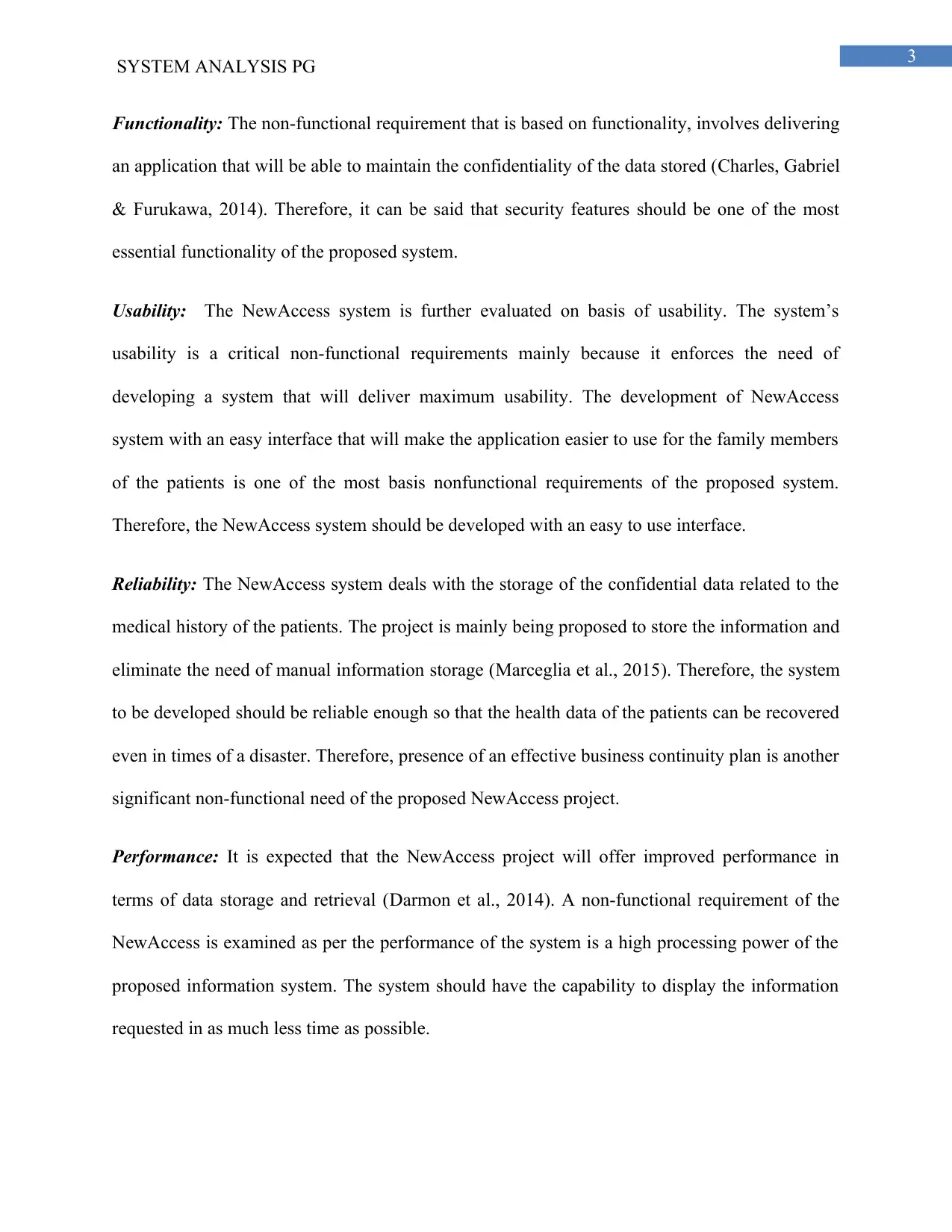
3
SYSTEM ANALYSIS PG
Functionality: The non-functional requirement that is based on functionality, involves delivering
an application that will be able to maintain the confidentiality of the data stored (Charles, Gabriel
& Furukawa, 2014). Therefore, it can be said that security features should be one of the most
essential functionality of the proposed system.
Usability: The NewAccess system is further evaluated on basis of usability. The system’s
usability is a critical non-functional requirements mainly because it enforces the need of
developing a system that will deliver maximum usability. The development of NewAccess
system with an easy interface that will make the application easier to use for the family members
of the patients is one of the most basis nonfunctional requirements of the proposed system.
Therefore, the NewAccess system should be developed with an easy to use interface.
Reliability: The NewAccess system deals with the storage of the confidential data related to the
medical history of the patients. The project is mainly being proposed to store the information and
eliminate the need of manual information storage (Marceglia et al., 2015). Therefore, the system
to be developed should be reliable enough so that the health data of the patients can be recovered
even in times of a disaster. Therefore, presence of an effective business continuity plan is another
significant non-functional need of the proposed NewAccess project.
Performance: It is expected that the NewAccess project will offer improved performance in
terms of data storage and retrieval (Darmon et al., 2014). A non-functional requirement of the
NewAccess is examined as per the performance of the system is a high processing power of the
proposed information system. The system should have the capability to display the information
requested in as much less time as possible.
SYSTEM ANALYSIS PG
Functionality: The non-functional requirement that is based on functionality, involves delivering
an application that will be able to maintain the confidentiality of the data stored (Charles, Gabriel
& Furukawa, 2014). Therefore, it can be said that security features should be one of the most
essential functionality of the proposed system.
Usability: The NewAccess system is further evaluated on basis of usability. The system’s
usability is a critical non-functional requirements mainly because it enforces the need of
developing a system that will deliver maximum usability. The development of NewAccess
system with an easy interface that will make the application easier to use for the family members
of the patients is one of the most basis nonfunctional requirements of the proposed system.
Therefore, the NewAccess system should be developed with an easy to use interface.
Reliability: The NewAccess system deals with the storage of the confidential data related to the
medical history of the patients. The project is mainly being proposed to store the information and
eliminate the need of manual information storage (Marceglia et al., 2015). Therefore, the system
to be developed should be reliable enough so that the health data of the patients can be recovered
even in times of a disaster. Therefore, presence of an effective business continuity plan is another
significant non-functional need of the proposed NewAccess project.
Performance: It is expected that the NewAccess project will offer improved performance in
terms of data storage and retrieval (Darmon et al., 2014). A non-functional requirement of the
NewAccess is examined as per the performance of the system is a high processing power of the
proposed information system. The system should have the capability to display the information
requested in as much less time as possible.
Paraphrase This Document
Need a fresh take? Get an instant paraphrase of this document with our AI Paraphraser
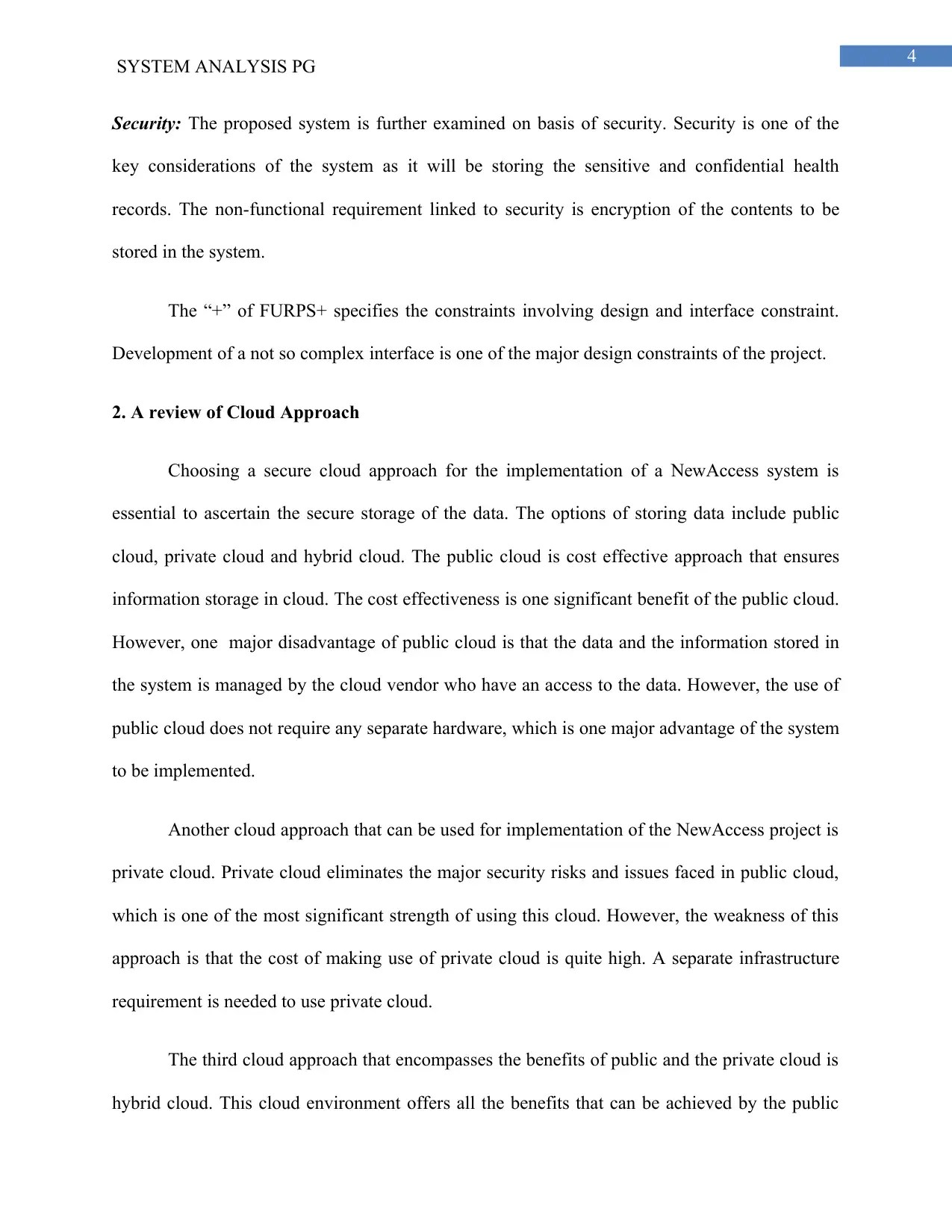
4
SYSTEM ANALYSIS PG
Security: The proposed system is further examined on basis of security. Security is one of the
key considerations of the system as it will be storing the sensitive and confidential health
records. The non-functional requirement linked to security is encryption of the contents to be
stored in the system.
The “+” of FURPS+ specifies the constraints involving design and interface constraint.
Development of a not so complex interface is one of the major design constraints of the project.
2. A review of Cloud Approach
Choosing a secure cloud approach for the implementation of a NewAccess system is
essential to ascertain the secure storage of the data. The options of storing data include public
cloud, private cloud and hybrid cloud. The public cloud is cost effective approach that ensures
information storage in cloud. The cost effectiveness is one significant benefit of the public cloud.
However, one major disadvantage of public cloud is that the data and the information stored in
the system is managed by the cloud vendor who have an access to the data. However, the use of
public cloud does not require any separate hardware, which is one major advantage of the system
to be implemented.
Another cloud approach that can be used for implementation of the NewAccess project is
private cloud. Private cloud eliminates the major security risks and issues faced in public cloud,
which is one of the most significant strength of using this cloud. However, the weakness of this
approach is that the cost of making use of private cloud is quite high. A separate infrastructure
requirement is needed to use private cloud.
The third cloud approach that encompasses the benefits of public and the private cloud is
hybrid cloud. This cloud environment offers all the benefits that can be achieved by the public
SYSTEM ANALYSIS PG
Security: The proposed system is further examined on basis of security. Security is one of the
key considerations of the system as it will be storing the sensitive and confidential health
records. The non-functional requirement linked to security is encryption of the contents to be
stored in the system.
The “+” of FURPS+ specifies the constraints involving design and interface constraint.
Development of a not so complex interface is one of the major design constraints of the project.
2. A review of Cloud Approach
Choosing a secure cloud approach for the implementation of a NewAccess system is
essential to ascertain the secure storage of the data. The options of storing data include public
cloud, private cloud and hybrid cloud. The public cloud is cost effective approach that ensures
information storage in cloud. The cost effectiveness is one significant benefit of the public cloud.
However, one major disadvantage of public cloud is that the data and the information stored in
the system is managed by the cloud vendor who have an access to the data. However, the use of
public cloud does not require any separate hardware, which is one major advantage of the system
to be implemented.
Another cloud approach that can be used for implementation of the NewAccess project is
private cloud. Private cloud eliminates the major security risks and issues faced in public cloud,
which is one of the most significant strength of using this cloud. However, the weakness of this
approach is that the cost of making use of private cloud is quite high. A separate infrastructure
requirement is needed to use private cloud.
The third cloud approach that encompasses the benefits of public and the private cloud is
hybrid cloud. This cloud environment offers all the benefits that can be achieved by the public
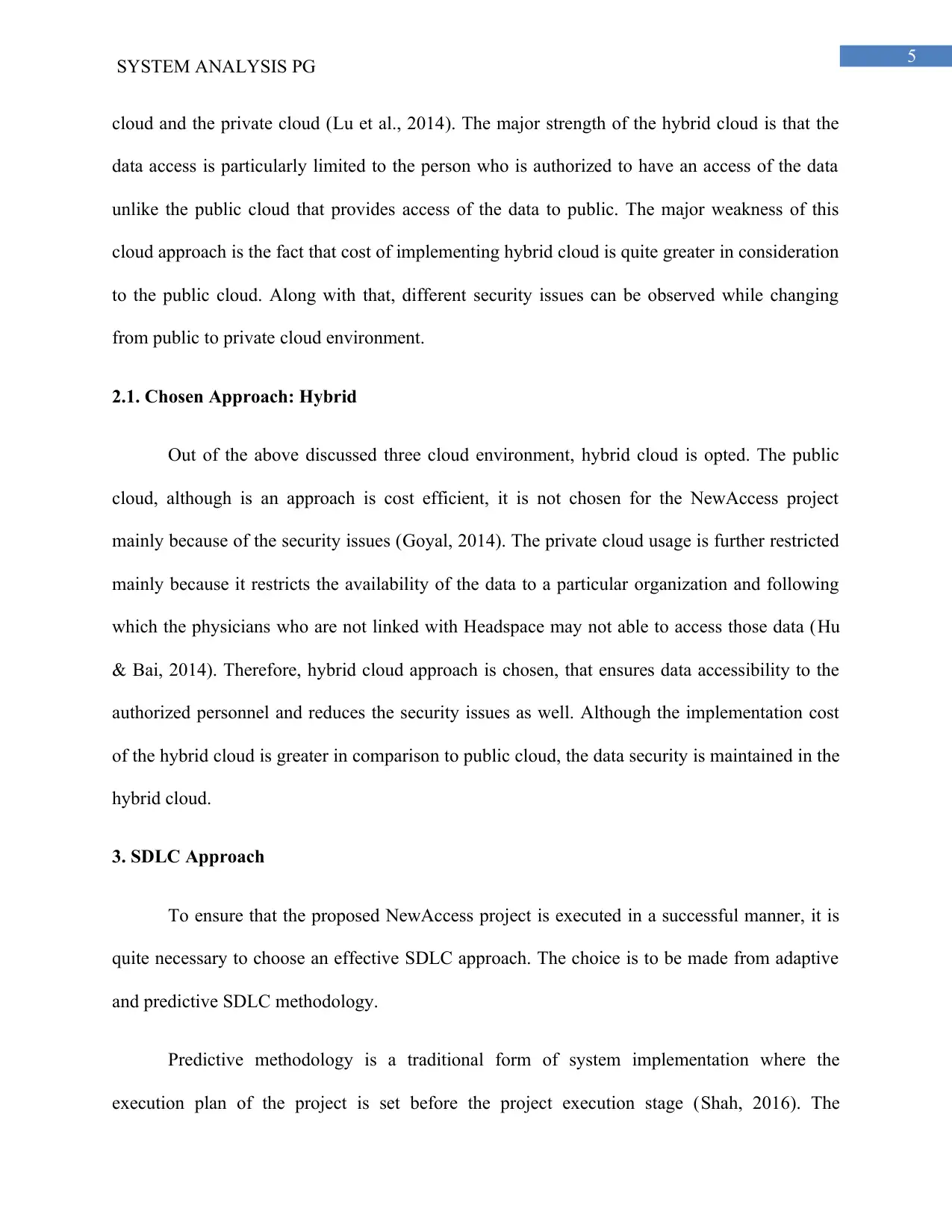
5
SYSTEM ANALYSIS PG
cloud and the private cloud (Lu et al., 2014). The major strength of the hybrid cloud is that the
data access is particularly limited to the person who is authorized to have an access of the data
unlike the public cloud that provides access of the data to public. The major weakness of this
cloud approach is the fact that cost of implementing hybrid cloud is quite greater in consideration
to the public cloud. Along with that, different security issues can be observed while changing
from public to private cloud environment.
2.1. Chosen Approach: Hybrid
Out of the above discussed three cloud environment, hybrid cloud is opted. The public
cloud, although is an approach is cost efficient, it is not chosen for the NewAccess project
mainly because of the security issues (Goyal, 2014). The private cloud usage is further restricted
mainly because it restricts the availability of the data to a particular organization and following
which the physicians who are not linked with Headspace may not able to access those data (Hu
& Bai, 2014). Therefore, hybrid cloud approach is chosen, that ensures data accessibility to the
authorized personnel and reduces the security issues as well. Although the implementation cost
of the hybrid cloud is greater in comparison to public cloud, the data security is maintained in the
hybrid cloud.
3. SDLC Approach
To ensure that the proposed NewAccess project is executed in a successful manner, it is
quite necessary to choose an effective SDLC approach. The choice is to be made from adaptive
and predictive SDLC methodology.
Predictive methodology is a traditional form of system implementation where the
execution plan of the project is set before the project execution stage (Shah, 2016). The
SYSTEM ANALYSIS PG
cloud and the private cloud (Lu et al., 2014). The major strength of the hybrid cloud is that the
data access is particularly limited to the person who is authorized to have an access of the data
unlike the public cloud that provides access of the data to public. The major weakness of this
cloud approach is the fact that cost of implementing hybrid cloud is quite greater in consideration
to the public cloud. Along with that, different security issues can be observed while changing
from public to private cloud environment.
2.1. Chosen Approach: Hybrid
Out of the above discussed three cloud environment, hybrid cloud is opted. The public
cloud, although is an approach is cost efficient, it is not chosen for the NewAccess project
mainly because of the security issues (Goyal, 2014). The private cloud usage is further restricted
mainly because it restricts the availability of the data to a particular organization and following
which the physicians who are not linked with Headspace may not able to access those data (Hu
& Bai, 2014). Therefore, hybrid cloud approach is chosen, that ensures data accessibility to the
authorized personnel and reduces the security issues as well. Although the implementation cost
of the hybrid cloud is greater in comparison to public cloud, the data security is maintained in the
hybrid cloud.
3. SDLC Approach
To ensure that the proposed NewAccess project is executed in a successful manner, it is
quite necessary to choose an effective SDLC approach. The choice is to be made from adaptive
and predictive SDLC methodology.
Predictive methodology is a traditional form of system implementation where the
execution plan of the project is set before the project execution stage (Shah, 2016). The
⊘ This is a preview!⊘
Do you want full access?
Subscribe today to unlock all pages.

Trusted by 1+ million students worldwide
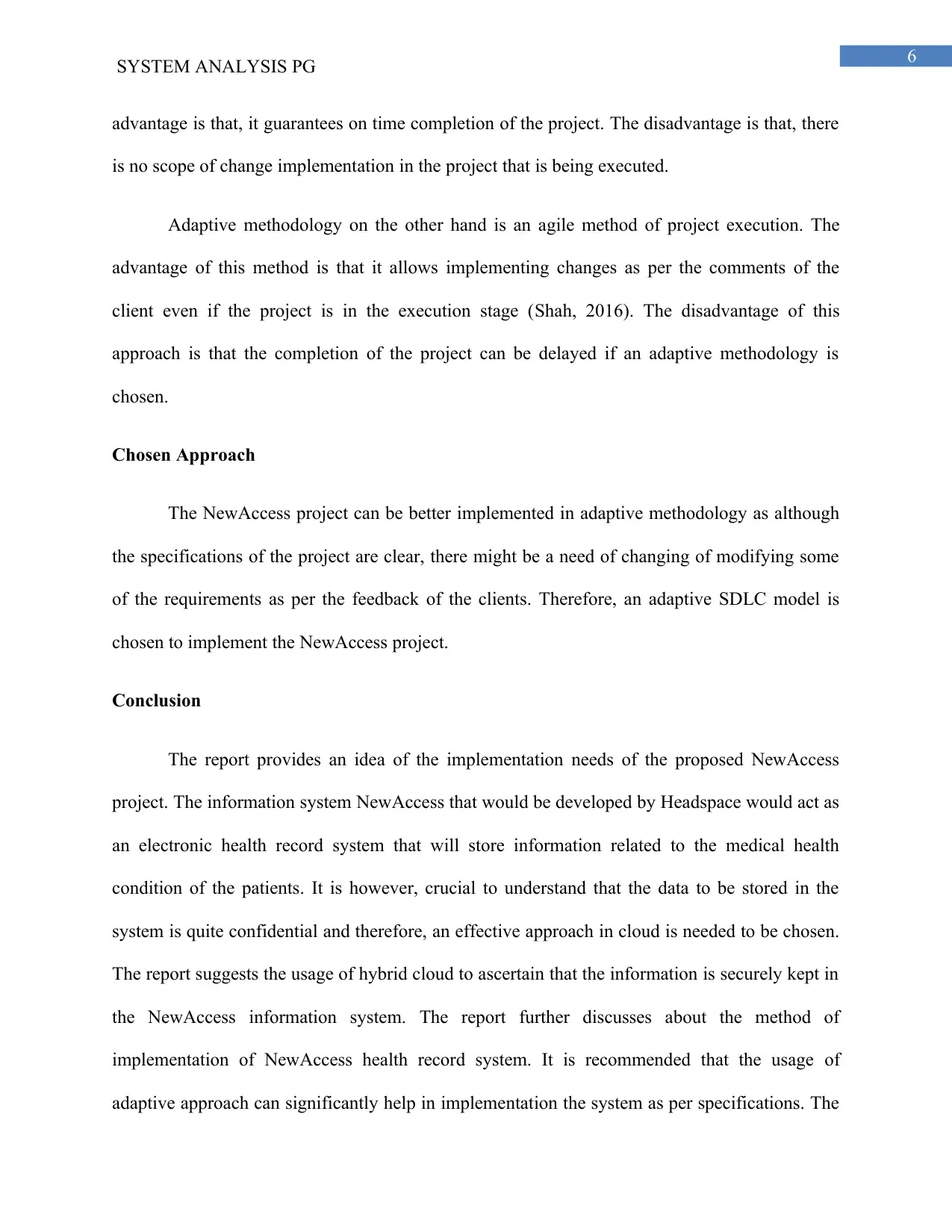
6
SYSTEM ANALYSIS PG
advantage is that, it guarantees on time completion of the project. The disadvantage is that, there
is no scope of change implementation in the project that is being executed.
Adaptive methodology on the other hand is an agile method of project execution. The
advantage of this method is that it allows implementing changes as per the comments of the
client even if the project is in the execution stage (Shah, 2016). The disadvantage of this
approach is that the completion of the project can be delayed if an adaptive methodology is
chosen.
Chosen Approach
The NewAccess project can be better implemented in adaptive methodology as although
the specifications of the project are clear, there might be a need of changing of modifying some
of the requirements as per the feedback of the clients. Therefore, an adaptive SDLC model is
chosen to implement the NewAccess project.
Conclusion
The report provides an idea of the implementation needs of the proposed NewAccess
project. The information system NewAccess that would be developed by Headspace would act as
an electronic health record system that will store information related to the medical health
condition of the patients. It is however, crucial to understand that the data to be stored in the
system is quite confidential and therefore, an effective approach in cloud is needed to be chosen.
The report suggests the usage of hybrid cloud to ascertain that the information is securely kept in
the NewAccess information system. The report further discusses about the method of
implementation of NewAccess health record system. It is recommended that the usage of
adaptive approach can significantly help in implementation the system as per specifications. The
SYSTEM ANALYSIS PG
advantage is that, it guarantees on time completion of the project. The disadvantage is that, there
is no scope of change implementation in the project that is being executed.
Adaptive methodology on the other hand is an agile method of project execution. The
advantage of this method is that it allows implementing changes as per the comments of the
client even if the project is in the execution stage (Shah, 2016). The disadvantage of this
approach is that the completion of the project can be delayed if an adaptive methodology is
chosen.
Chosen Approach
The NewAccess project can be better implemented in adaptive methodology as although
the specifications of the project are clear, there might be a need of changing of modifying some
of the requirements as per the feedback of the clients. Therefore, an adaptive SDLC model is
chosen to implement the NewAccess project.
Conclusion
The report provides an idea of the implementation needs of the proposed NewAccess
project. The information system NewAccess that would be developed by Headspace would act as
an electronic health record system that will store information related to the medical health
condition of the patients. It is however, crucial to understand that the data to be stored in the
system is quite confidential and therefore, an effective approach in cloud is needed to be chosen.
The report suggests the usage of hybrid cloud to ascertain that the information is securely kept in
the NewAccess information system. The report further discusses about the method of
implementation of NewAccess health record system. It is recommended that the usage of
adaptive approach can significantly help in implementation the system as per specifications. The
Paraphrase This Document
Need a fresh take? Get an instant paraphrase of this document with our AI Paraphraser
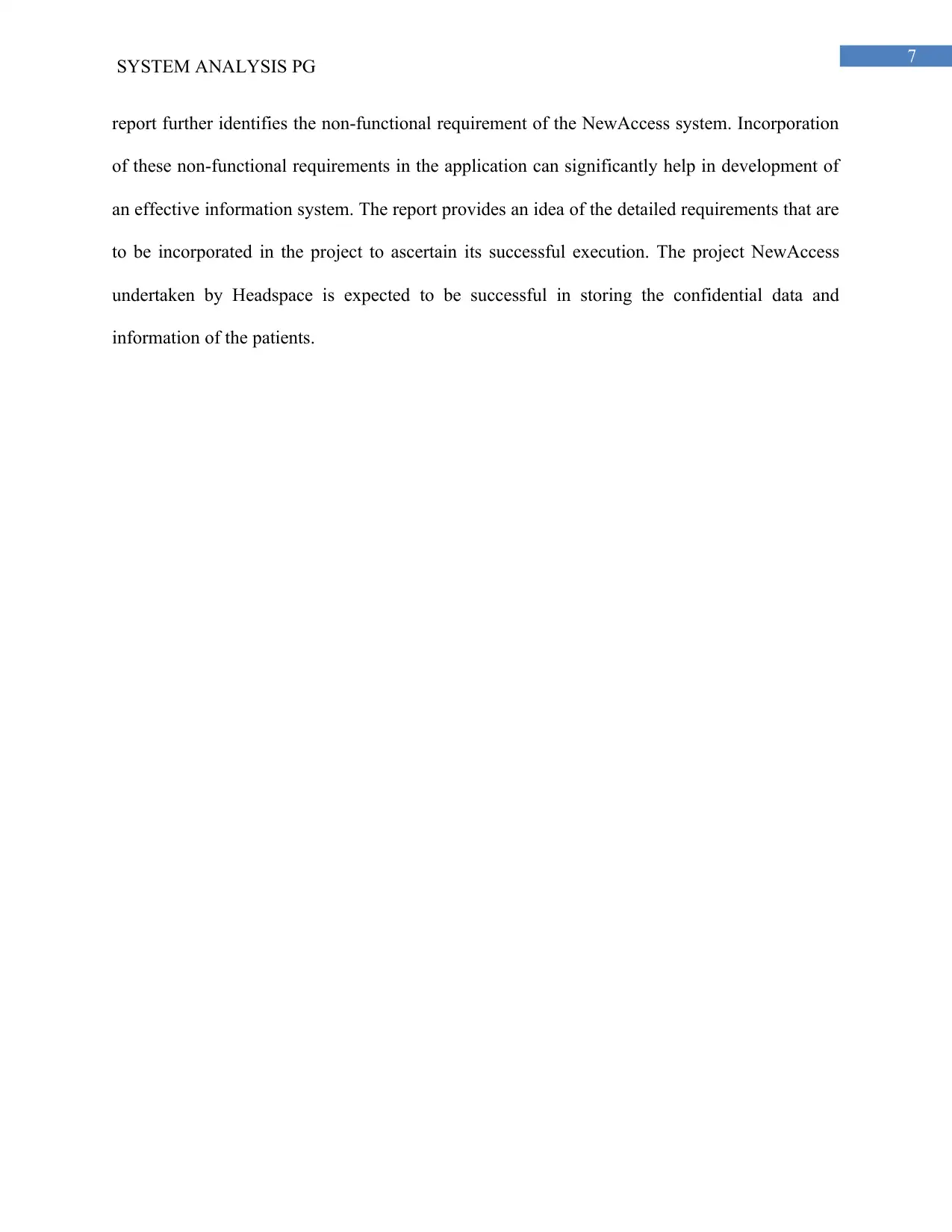
7
SYSTEM ANALYSIS PG
report further identifies the non-functional requirement of the NewAccess system. Incorporation
of these non-functional requirements in the application can significantly help in development of
an effective information system. The report provides an idea of the detailed requirements that are
to be incorporated in the project to ascertain its successful execution. The project NewAccess
undertaken by Headspace is expected to be successful in storing the confidential data and
information of the patients.
SYSTEM ANALYSIS PG
report further identifies the non-functional requirement of the NewAccess system. Incorporation
of these non-functional requirements in the application can significantly help in development of
an effective information system. The report provides an idea of the detailed requirements that are
to be incorporated in the project to ascertain its successful execution. The project NewAccess
undertaken by Headspace is expected to be successful in storing the confidential data and
information of the patients.
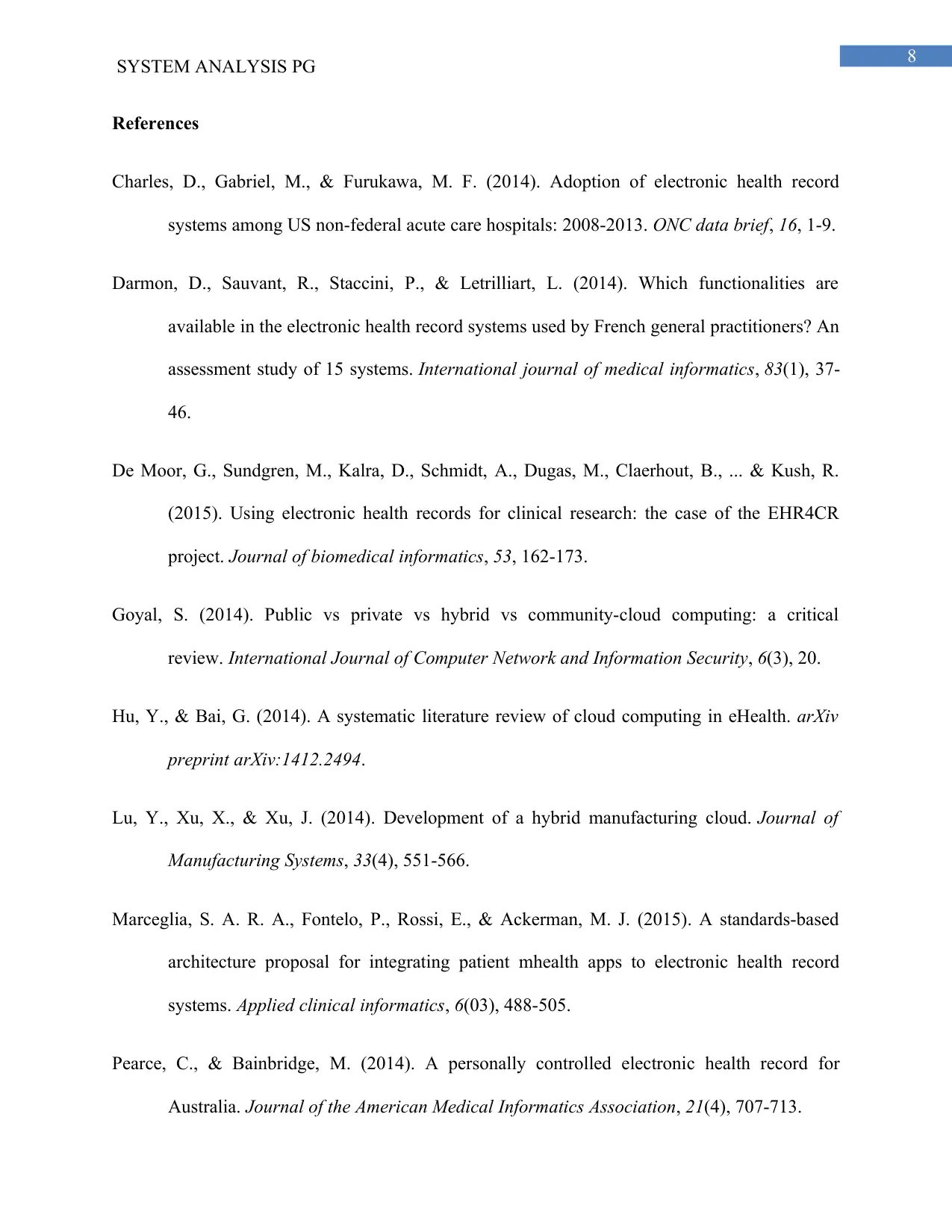
8
SYSTEM ANALYSIS PG
References
Charles, D., Gabriel, M., & Furukawa, M. F. (2014). Adoption of electronic health record
systems among US non-federal acute care hospitals: 2008-2013. ONC data brief, 16, 1-9.
Darmon, D., Sauvant, R., Staccini, P., & Letrilliart, L. (2014). Which functionalities are
available in the electronic health record systems used by French general practitioners? An
assessment study of 15 systems. International journal of medical informatics, 83(1), 37-
46.
De Moor, G., Sundgren, M., Kalra, D., Schmidt, A., Dugas, M., Claerhout, B., ... & Kush, R.
(2015). Using electronic health records for clinical research: the case of the EHR4CR
project. Journal of biomedical informatics, 53, 162-173.
Goyal, S. (2014). Public vs private vs hybrid vs community-cloud computing: a critical
review. International Journal of Computer Network and Information Security, 6(3), 20.
Hu, Y., & Bai, G. (2014). A systematic literature review of cloud computing in eHealth. arXiv
preprint arXiv:1412.2494.
Lu, Y., Xu, X., & Xu, J. (2014). Development of a hybrid manufacturing cloud. Journal of
Manufacturing Systems, 33(4), 551-566.
Marceglia, S. A. R. A., Fontelo, P., Rossi, E., & Ackerman, M. J. (2015). A standards-based
architecture proposal for integrating patient mhealth apps to electronic health record
systems. Applied clinical informatics, 6(03), 488-505.
Pearce, C., & Bainbridge, M. (2014). A personally controlled electronic health record for
Australia. Journal of the American Medical Informatics Association, 21(4), 707-713.
SYSTEM ANALYSIS PG
References
Charles, D., Gabriel, M., & Furukawa, M. F. (2014). Adoption of electronic health record
systems among US non-federal acute care hospitals: 2008-2013. ONC data brief, 16, 1-9.
Darmon, D., Sauvant, R., Staccini, P., & Letrilliart, L. (2014). Which functionalities are
available in the electronic health record systems used by French general practitioners? An
assessment study of 15 systems. International journal of medical informatics, 83(1), 37-
46.
De Moor, G., Sundgren, M., Kalra, D., Schmidt, A., Dugas, M., Claerhout, B., ... & Kush, R.
(2015). Using electronic health records for clinical research: the case of the EHR4CR
project. Journal of biomedical informatics, 53, 162-173.
Goyal, S. (2014). Public vs private vs hybrid vs community-cloud computing: a critical
review. International Journal of Computer Network and Information Security, 6(3), 20.
Hu, Y., & Bai, G. (2014). A systematic literature review of cloud computing in eHealth. arXiv
preprint arXiv:1412.2494.
Lu, Y., Xu, X., & Xu, J. (2014). Development of a hybrid manufacturing cloud. Journal of
Manufacturing Systems, 33(4), 551-566.
Marceglia, S. A. R. A., Fontelo, P., Rossi, E., & Ackerman, M. J. (2015). A standards-based
architecture proposal for integrating patient mhealth apps to electronic health record
systems. Applied clinical informatics, 6(03), 488-505.
Pearce, C., & Bainbridge, M. (2014). A personally controlled electronic health record for
Australia. Journal of the American Medical Informatics Association, 21(4), 707-713.
⊘ This is a preview!⊘
Do you want full access?
Subscribe today to unlock all pages.

Trusted by 1+ million students worldwide
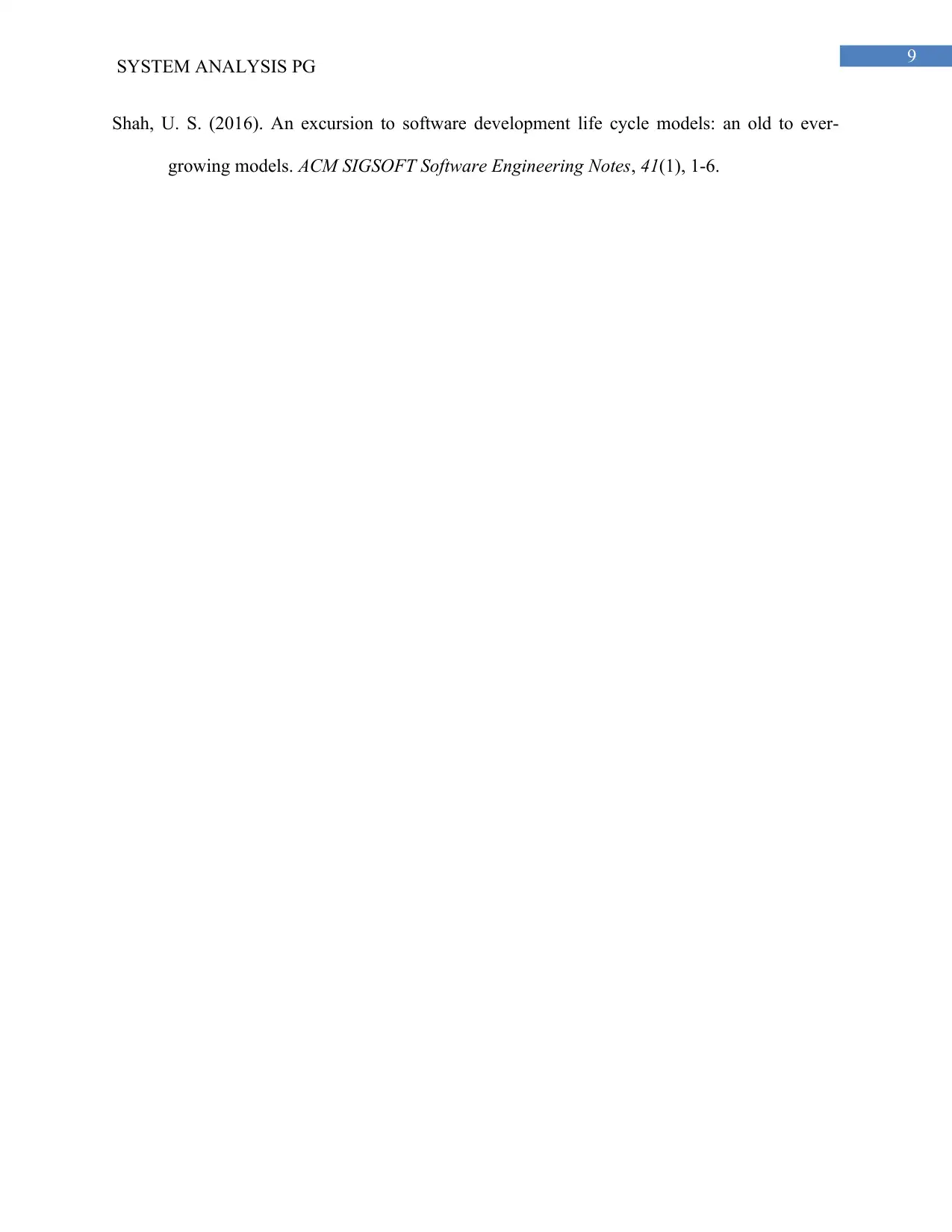
9
SYSTEM ANALYSIS PG
Shah, U. S. (2016). An excursion to software development life cycle models: an old to ever-
growing models. ACM SIGSOFT Software Engineering Notes, 41(1), 1-6.
SYSTEM ANALYSIS PG
Shah, U. S. (2016). An excursion to software development life cycle models: an old to ever-
growing models. ACM SIGSOFT Software Engineering Notes, 41(1), 1-6.
1 out of 10
Related Documents
Your All-in-One AI-Powered Toolkit for Academic Success.
+13062052269
info@desklib.com
Available 24*7 on WhatsApp / Email
![[object Object]](/_next/static/media/star-bottom.7253800d.svg)
Unlock your academic potential
Copyright © 2020–2025 A2Z Services. All Rights Reserved. Developed and managed by ZUCOL.



